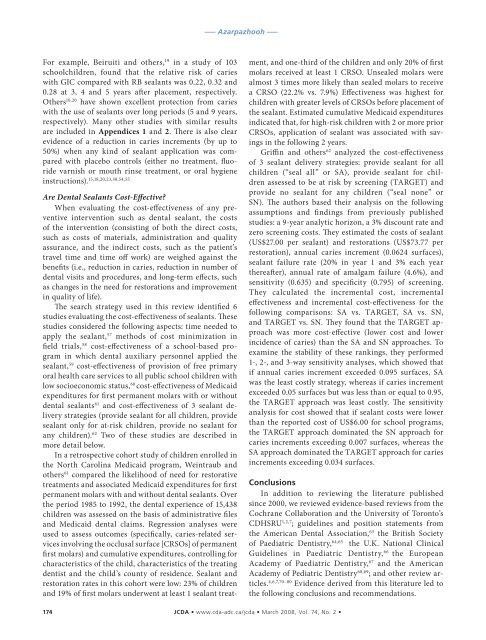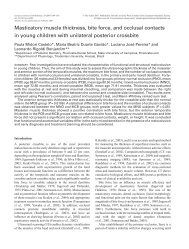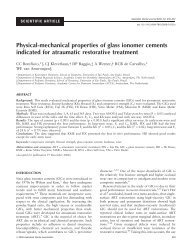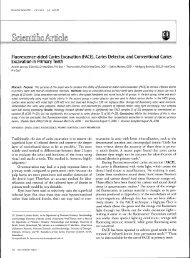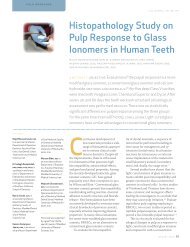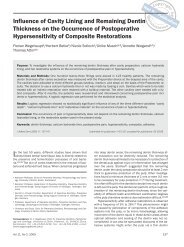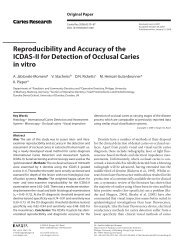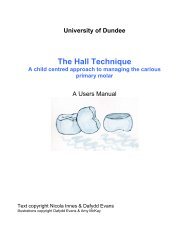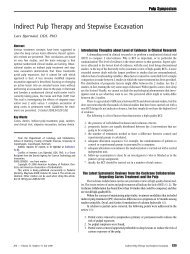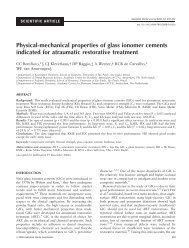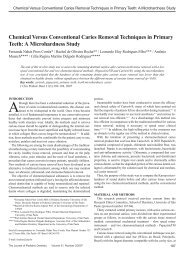Pit and Fissure Sealants in the Prevention of Dental Caries in ...
Pit and Fissure Sealants in the Prevention of Dental Caries in ...
Pit and Fissure Sealants in the Prevention of Dental Caries in ...
Create successful ePaper yourself
Turn your PDF publications into a flip-book with our unique Google optimized e-Paper software.
––– Azarpazhooh –––<br />
For example, Beiruiti <strong>and</strong> o<strong>the</strong>rs, 19 <strong>in</strong> a study <strong>of</strong> 103<br />
schoolchildren, found that <strong>the</strong> relative risk <strong>of</strong> caries<br />
with GIC compared with RB sealants was 0.22, 0.32 <strong>and</strong><br />
0.28 at 3, 4 <strong>and</strong> 5 years after placement, respectively.<br />
O<strong>the</strong>rs 10,20 have shown excellent protection from caries<br />
with <strong>the</strong> use <strong>of</strong> sealants over long periods (5 <strong>and</strong> 9 years,<br />
respectively). Many o<strong>the</strong>r studies with similar results<br />
are <strong>in</strong>cluded <strong>in</strong> Appendices 1 <strong>and</strong> 2. There is also clear<br />
evidence <strong>of</strong> a reduction <strong>in</strong> caries <strong>in</strong>crements (by up to<br />
50%) when any k<strong>in</strong>d <strong>of</strong> sealant application was compared<br />
with placebo controls (ei<strong>the</strong>r no treatment, fluoride<br />
varnish or mouth r<strong>in</strong>se treatment, or oral hygiene<br />
<strong>in</strong>structions). 15,18,20,23,30,54,55<br />
Are <strong>Dental</strong> <strong>Sealants</strong> Cost-Effective<br />
When evaluat<strong>in</strong>g <strong>the</strong> cost-effectiveness <strong>of</strong> any preventive<br />
<strong>in</strong>tervention such as dental sealant, <strong>the</strong> costs<br />
<strong>of</strong> <strong>the</strong> <strong>in</strong>tervention (consist<strong>in</strong>g <strong>of</strong> both <strong>the</strong> direct costs,<br />
such as costs <strong>of</strong> materials, adm<strong>in</strong>istration <strong>and</strong> quality<br />
assurance, <strong>and</strong> <strong>the</strong> <strong>in</strong>direct costs, such as <strong>the</strong> patient’s<br />
travel time <strong>and</strong> time <strong>of</strong>f work) are weighed aga<strong>in</strong>st <strong>the</strong><br />
benefits (i.e., reduction <strong>in</strong> caries, reduction <strong>in</strong> number <strong>of</strong><br />
dental visits <strong>and</strong> procedures, <strong>and</strong> long-term effects, such<br />
as changes <strong>in</strong> <strong>the</strong> need for restorations <strong>and</strong> improvement<br />
<strong>in</strong> quality <strong>of</strong> life).<br />
The search strategy used <strong>in</strong> this review identified 6<br />
studies evaluat<strong>in</strong>g <strong>the</strong> cost-effectiveness <strong>of</strong> sealants. These<br />
studies considered <strong>the</strong> follow<strong>in</strong>g aspects: time needed to<br />
apply <strong>the</strong> sealant, 57 methods <strong>of</strong> cost m<strong>in</strong>imization <strong>in</strong><br />
field trials, 58 cost-effectiveness <strong>of</strong> a school-based program<br />
<strong>in</strong> which dental auxiliary personnel applied <strong>the</strong><br />
sealant, 59 cost-effectiveness <strong>of</strong> provision <strong>of</strong> free primary<br />
oral health care services to all public school children with<br />
low socioeconomic status, 60 cost-effectiveness <strong>of</strong> Medicaid<br />
expenditures for first permanent molars with or without<br />
dental sealants 61 <strong>and</strong> cost-effectiveness <strong>of</strong> 3 sealant delivery<br />
strategies (provide sealant for all children, provide<br />
sealant only for at-risk children, provide no sealant for<br />
any children). 62 Two <strong>of</strong> <strong>the</strong>se studies are described <strong>in</strong><br />
more detail below.<br />
In a retrospective cohort study <strong>of</strong> children enrolled <strong>in</strong><br />
<strong>the</strong> North Carol<strong>in</strong>a Medicaid program, We<strong>in</strong>traub <strong>and</strong><br />
o<strong>the</strong>rs 61 compared <strong>the</strong> likelihood <strong>of</strong> need for restorative<br />
treatments <strong>and</strong> associated Medicaid expenditures for first<br />
permanent molars with <strong>and</strong> without dental sealants. Over<br />
<strong>the</strong> period 1985 to 1992, <strong>the</strong> dental experience <strong>of</strong> 15,438<br />
children was assessed on <strong>the</strong> basis <strong>of</strong> adm<strong>in</strong>istrative files<br />
<strong>and</strong> Medicaid dental claims. Regression analyses were<br />
used to assess outcomes (specifically, caries-related services<br />
<strong>in</strong>volv<strong>in</strong>g <strong>the</strong> occlusal surface [CRSOs] <strong>of</strong> permanent<br />
first molars) <strong>and</strong> cumulative expenditures, controll<strong>in</strong>g for<br />
characteristics <strong>of</strong> <strong>the</strong> child, characteristics <strong>of</strong> <strong>the</strong> treat<strong>in</strong>g<br />
dentist <strong>and</strong> <strong>the</strong> child’s county <strong>of</strong> residence. Sealant <strong>and</strong><br />
restoration rates <strong>in</strong> this cohort were low: 23% <strong>of</strong> children<br />
<strong>and</strong> 19% <strong>of</strong> first molars underwent at least 1 sealant treatment,<br />
<strong>and</strong> one-third <strong>of</strong> <strong>the</strong> children <strong>and</strong> only 20% <strong>of</strong> first<br />
molars received at least 1 CRSO. Unsealed molars were<br />
almost 3 times more likely than sealed molars to receive<br />
a CRSO (22.2% vs. 7.9%) Effectiveness was highest for<br />
children with greater levels <strong>of</strong> CRSOs before placement <strong>of</strong><br />
<strong>the</strong> sealant. Estimated cumulative Medicaid expenditures<br />
<strong>in</strong>dicated that, for high-risk children with 2 or more prior<br />
CRSOs, application <strong>of</strong> sealant was associated with sav<strong>in</strong>gs<br />
<strong>in</strong> <strong>the</strong> follow<strong>in</strong>g 2 years.<br />
Griff<strong>in</strong> <strong>and</strong> o<strong>the</strong>rs 62 analyzed <strong>the</strong> cost-effectiveness<br />
<strong>of</strong> 3 sealant delivery strategies: provide sealant for all<br />
children (“seal all” or SA), provide sealant for children<br />
assessed to be at risk by screen<strong>in</strong>g (TARGET) <strong>and</strong><br />
provide no sealant for any children (“seal none” or<br />
SN). The authors based <strong>the</strong>ir analysis on <strong>the</strong> follow<strong>in</strong>g<br />
assumptions <strong>and</strong> f<strong>in</strong>d<strong>in</strong>gs from previously published<br />
studies: a 9-year analytic horizon, a 3% discount rate <strong>and</strong><br />
zero screen<strong>in</strong>g costs. They estimated <strong>the</strong> costs <strong>of</strong> sealant<br />
(US$27.00 per sealant) <strong>and</strong> restorations (US$73.77 per<br />
restoration), annual caries <strong>in</strong>crement (0.0624 surfaces),<br />
sealant failure rate (20% <strong>in</strong> year 1 <strong>and</strong> 3% each year<br />
<strong>the</strong>reafter), annual rate <strong>of</strong> amalgam failure (4.6%), <strong>and</strong><br />
sensitivity (0.635) <strong>and</strong> specificity (0.795) <strong>of</strong> screen<strong>in</strong>g.<br />
They calculated <strong>the</strong> <strong>in</strong>cremental cost, <strong>in</strong>cremental<br />
effectiveness <strong>and</strong> <strong>in</strong>cremental cost-effectiveness for <strong>the</strong><br />
follow<strong>in</strong>g comparisons: SA vs. TARGET, SA vs. SN,<br />
<strong>and</strong> TARGET vs. SN. They found that <strong>the</strong> TARGET approach<br />
was more cost-effective (lower cost <strong>and</strong> lower<br />
<strong>in</strong>cidence <strong>of</strong> caries) than <strong>the</strong> SA <strong>and</strong> SN approaches. To<br />
exam<strong>in</strong>e <strong>the</strong> stability <strong>of</strong> <strong>the</strong>se rank<strong>in</strong>gs, <strong>the</strong>y performed<br />
1-, 2-, <strong>and</strong> 3-way sensitivity analyses, which showed that<br />
if annual caries <strong>in</strong>crement exceeded 0.095 surfaces, SA<br />
was <strong>the</strong> least costly strategy, whereas if caries <strong>in</strong>crement<br />
exceeded 0.05 surfaces but was less than or equal to 0.95,<br />
<strong>the</strong> TARGET approach was least costly. The sensitivity<br />
analysis for cost showed that if sealant costs were lower<br />
than <strong>the</strong> reported cost <strong>of</strong> US$6.00 for school programs,<br />
<strong>the</strong> TARGET approach dom<strong>in</strong>ated <strong>the</strong> SN approach for<br />
caries <strong>in</strong>crements exceed<strong>in</strong>g 0.007 surfaces, whereas <strong>the</strong><br />
SA approach dom<strong>in</strong>ated <strong>the</strong> TARGET approach for caries<br />
<strong>in</strong>crements exceed<strong>in</strong>g 0.034 surfaces.<br />
Conclusions<br />
In addition to review<strong>in</strong>g <strong>the</strong> literature published<br />
s<strong>in</strong>ce 2000, we reviewed evidence-based reviews from <strong>the</strong><br />
Cochrane Collaboration <strong>and</strong> <strong>the</strong> University <strong>of</strong> Toronto’s<br />
CDHSRU 1,2,7 ; guidel<strong>in</strong>es <strong>and</strong> position statements from<br />
<strong>the</strong> American <strong>Dental</strong> Association, 63 <strong>the</strong> British Society<br />
<strong>of</strong> Paediatric Dentistry, 64,65 <strong>the</strong> U.K. National Cl<strong>in</strong>ical<br />
Guidel<strong>in</strong>es <strong>in</strong> Paediatric Dentistry, 66 <strong>the</strong> European<br />
Academy <strong>of</strong> Paediatric Dentistry, 67 <strong>and</strong> <strong>the</strong> American<br />
Academy <strong>of</strong> Pediatric Dentistry 68,69 ; <strong>and</strong> o<strong>the</strong>r review articles.<br />
4,6,7,70–80 Evidence derived from this literature led to<br />
<strong>the</strong> follow<strong>in</strong>g conclusions <strong>and</strong> recommendations.<br />
174 JCDA • www.cda-adc.ca/jcda • March 2008, Vol. 74, No. 2 •


